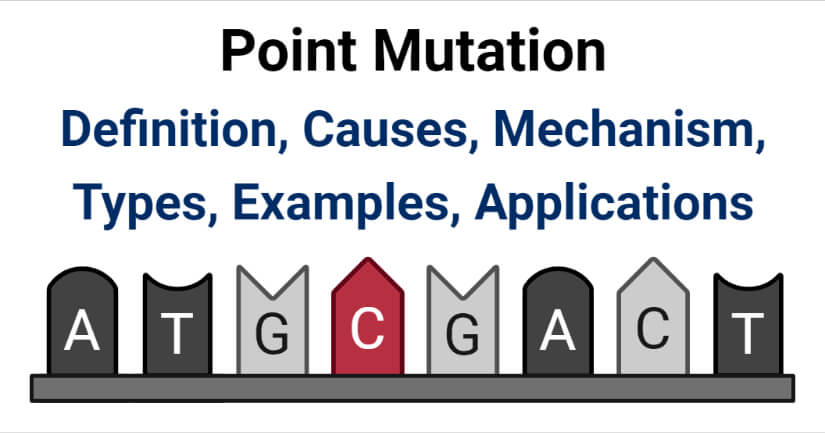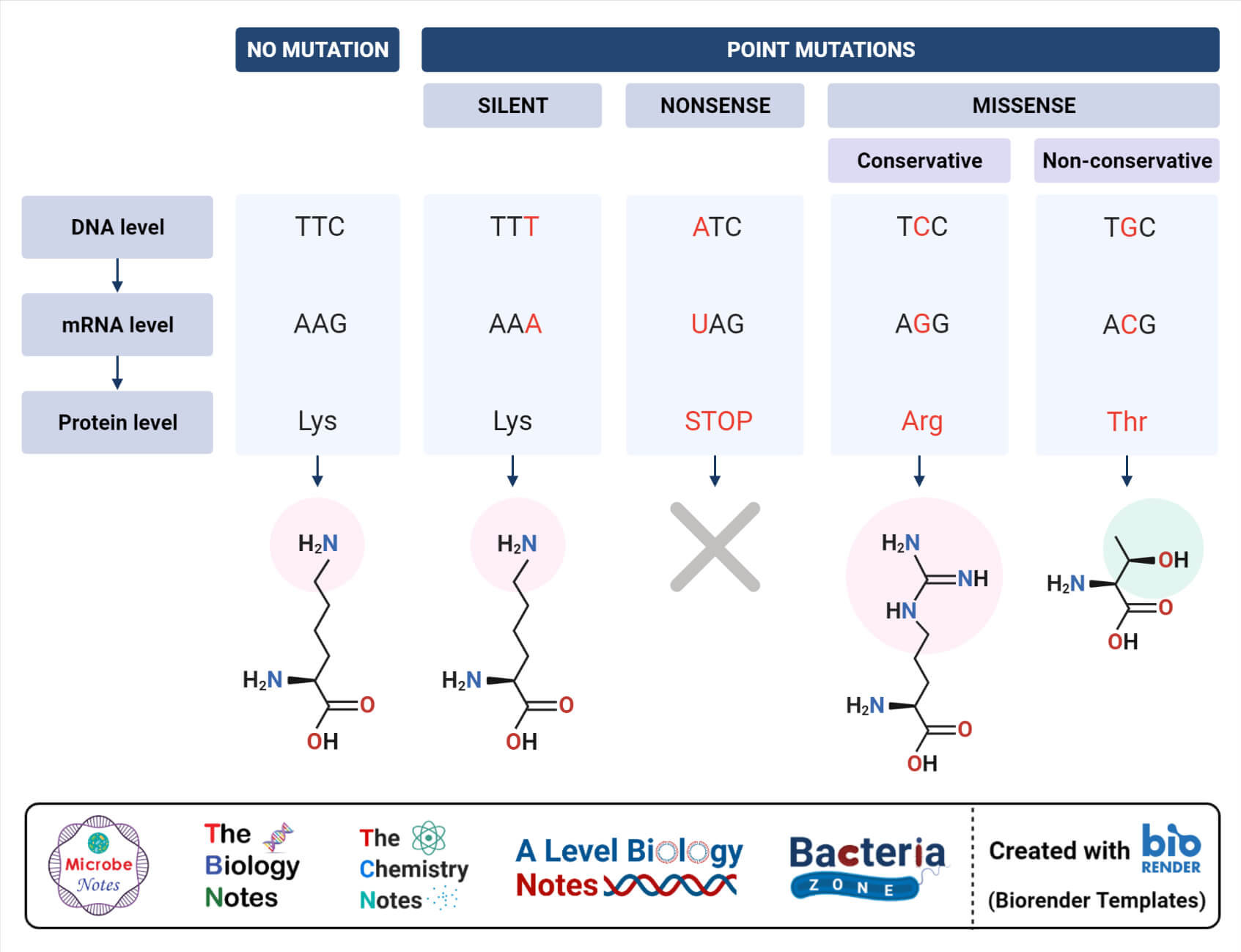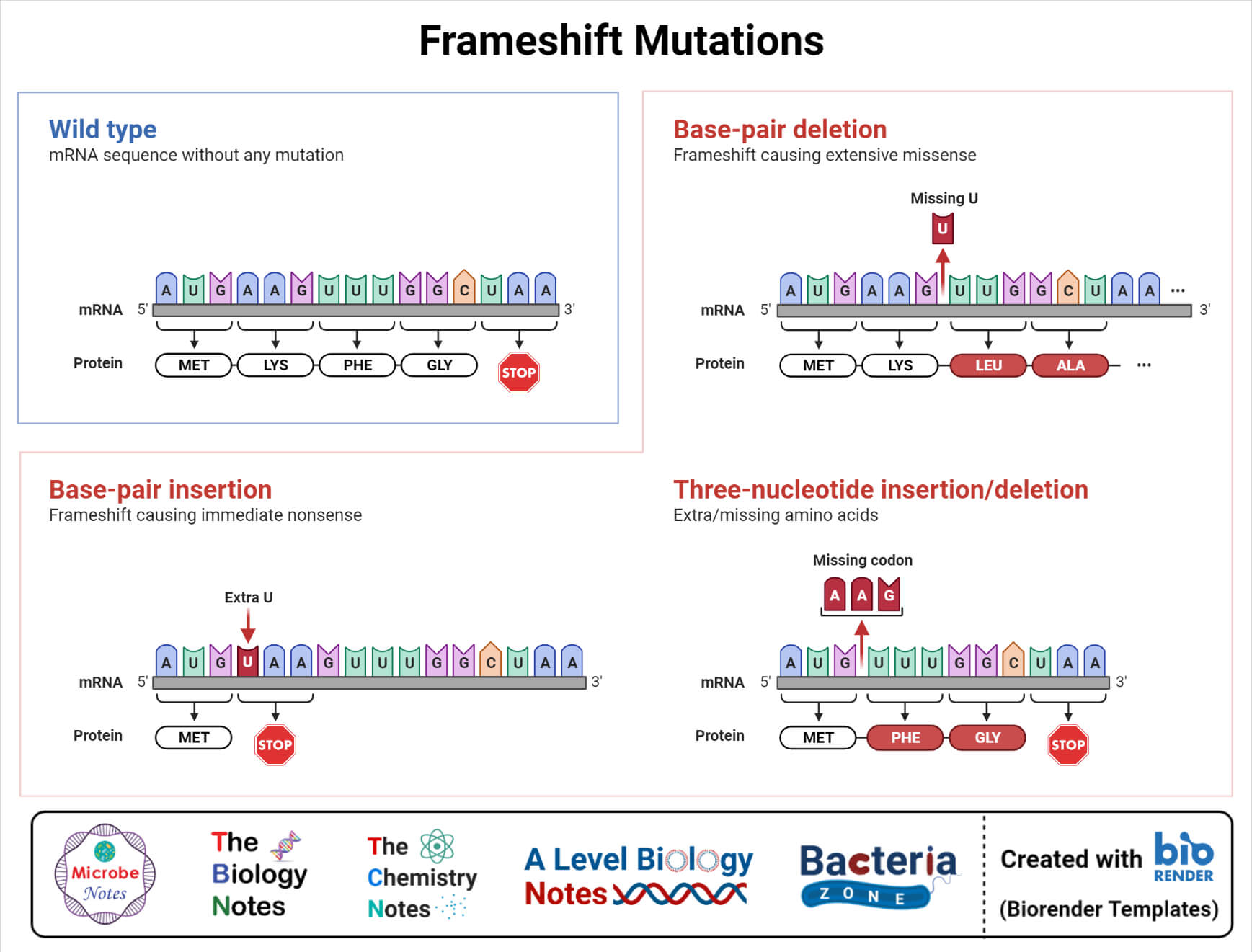Interesting Science Videos
Point mutation definition
Point mutation is a type of genetic mutation where one of the base pairs in the DNA sequence is altered either by insertion or deletion.
- Point mutation, as the name indicates, occurs at a particular point of the DNA sequence as a result of changes in one particular base pair.
- Usually, point mutations arise as a result of mistakes during DNA replication; however, in some cases, modification of DNA can be induced by X-rays or ultraviolet radiation.
- The effects of point mutations are often based on the specifics of the mutation as these can range from no effect to deleterious effects affecting protein production, composition, and function.
- Point mutation is a type of mutation that affects the structure of the chromosome, induced by changes in the nucleotide sequences.
- Point mutations can have important effects on the production of proteins as nucleotides are read in triplets, and the changes in the sequences might cause changes in the sequence of amino acids in the protein.
- Besides, the changes in the sequences at the beginning or the end of the sequence can also result in premature termination or initiation. Thus, the severity of mutation depends on the position of the mutation.

Causes of Point mutation
- Most point mutations occur during DNA replication, where a single point mutation in the sequence can change the entire DNA sequence.
- The change in either the purine or pyrimidine can change the amino acid sequence that the nucleotide codes for.
- These changes can be the result of spontaneous mutation occurring during DNA replication; however, the rate of these mutations increases with exposure to mutagens.
- The mutagens can be physical, like X-rays and UV radiation or chemical molecules that alter the base pairs and change the structure of the DNA.
- In the case of radiation, the light can cause ionization of the molecules in the DNA, which brings about changes in the composition of the sequence.
- Besides, the byproduct of cellular metabolism like reactive oxygen species, which might destroy particular base pairs in the structure.
- These kinds of changes can affect either the separated single-stranded DNA or the helical double strand.
- Some of these changes might arise later during the processing of the DNA, where the base pairs are digested by nucleases.
- Other forms of mutation like deletion, substitution, insertion, etc., can also be the cause of point mutation at different stages of DNA formation, replication, and processing.
Mechanism of Point mutation
There are different mechanisms of point mutation, depending on the cause of the mutation. Since, in most cases, point mutation arises spontaneously during DNA replication, the mechanism of substitution of a nucleotide is more common.
Substitution
- Substitution of a base pair for another during DNA replication is the most common mechanism of mutation.
- This usually occurs as a result of a tautomeric shift where the hydrogen atoms of a nucleotide base pair move away in a manner that changes the properties of the bonding.
- All the bases involved in DNA replication exist in different forms, called tautomers. These forms exist in equilibrium, where the keto form is usually found in the DNA, and the enol forms are usually rare.
- The shift in the structure between keto and enol form can change the complementary base pairing of the nucleotides, which can result in point mutations.
- An example of this can be observed in guanine, where its enol form will bind to incoming thymine instead of cytosine, resulting in a point mutation.
Ionization
- Ionization is the next common mechanism of mutation occurring as a result of chemical species or radiation.
- The bases can become spontaneously ionized into different forms that can no longer form hydrogen bonds with the complementary base pair.
- As a result, the base pair can bind to a different molecule or base pair, resulting in changes in the sequences.
Types of Point Mutations (based on the substitution of the base pairs)
Point mutations can be differentiated into two types depending on the nature of the substitution of the base pairs.
Transition mutations
- Transition mutations are mutations that occur due to the substitution of a pyrimidine base by another pyrimidine base or the substitution of one purine base for the other.
- Since the base pairs in a double-stranded DNA bind to specific partners on the corresponding strands, the substitution of one nitrogen base for another results in a different set of base pairs.
- Transition mutations are caused by oxidative deamination and tautomerization of the base pairs.
- These are more common in genomes due to the molecular mechanism involved to generate them, even though there is just a single possible transition.
- However, transition mutations are less likely to result in amino acid substitutions and therefore exist as silent substitutions in genomic populations like single nucleotide polymorphisms.
Example of transition mutation
- An example of transition mutation can be observed by the replacement of adenine by guanine or by the replacement of cytosine by thymine and vice versa.
- In these cases, the purine nucleotides are exchanged among themselves, and the pyrimidine nucleotides are exchanged among themselves.
Transversion mutations
- Transversion mutations are the mutations where the purine base substitutes for a pyrimidine base and vice versa.
- Transversion mutations are usually spontaneous, but these can be induced by radiation or alkylating agents. A reversible transversion is possible in the case of spontaneous mutation.
- There are two possible transversions, but these are less likely to occur as it is difficult to substitute a double ring structure for a single ring structure.
- A transversion, however, has a more pronounced effect as the third nucleotide codon of the DNA is less tolerant to transversion.
- A transversion seldom results in codons that encode for the amino acids, which brings about changes in the protein.
Example of transversion mutation
- An example of transversion mutation can be observed by the replacement of the adenine or guanine nucleotide by thymine or cytosine.
- There are eight possible changes that can occur between the two purine and two pyrimidines.
Types of Point Mutations (based on effects produced by the changes)
Point mutations can further be divided into different types depending on the effects produced by the changes.

1. Nonsense mutations
A nonsense mutation or point-nonsense mutation is a type of point mutation where the substitution of a base pair results in a premature stop codon.
- As a result of the point mutation, the segment of the DNA which previously contained a codon specifying an amino acid is replaced by a stop codon.
- The effect on the nonsense mutation depends on the position of the stop codon with a given segment. If the mutation is close to the original stop codon, the functional effect might be less severe than if the mutation is far from the stop codon.
- The mutation often leads to the production of shortened and nonfunctional protein units.
- A nonsense mutation is one of the more severe kinds of point mutation as it can result in the complete loss of function in the finished product.
Example of Nonsense mutation
- Beta thalassemias are a group of blood disorders that occur as a result of point nonsense mutation on the gene coding for the beta chains of hemoglobin.
- The result of the mutation can range from severe anemia to clinically asymptomatic cases depending on the position of the mutation.
- The point mutation, in this case, can either occur by the substitution of a single base or by the deletion of a nucleotide.
- The substitution occurs near the promoter regions preceding the beta-globin genes. In the case of deletion, certain nucleotides are deleted from the region near the upstream of the beta-globin gene.
- The alteration of the gene causes the formation of a premature stop codon which prevents the formation of the globin protein.
2. Missense mutations
A missense mutation is a type of point mutation where the substitution of a base pair results in a different amino acid in the resulting protein.
- Missense mutation can either have no effect or result in a nonfunctional protein depending on the substitution and the position.
- A missense mutation is commonly associated with diseases like Epidermolysis bullosa, sickle-cell disease, and ALS.
- However, all missense mutations are not as harmful as in some cases; an amino acid is replaced by another amino acid of similar properties, which results in a functional protein. This mutation is also termed silent mutation.
- Besides, the substitution can also occur at a position that doesn’t significantly affect the structure and function of a protein.
Example of Missense mutation
- Sickle cell anemia is a classic example of missense point mutation, where the mutation results in the production of different amino acids that affects the overall structure of the protein.
- This causes a change in the structure of the red blood cells while changing the ability of the cells to acquire oxygen and cause blood clotting.
- The point mutation, in this case, occurs at the upstream of the gene coding for the amino acids involved in the production of proteins forming the wall of the blood cell.
- The difference in nucleotides results in the production of a different amino acid which brings about the difference in the structure of the blood cell.
3. Silent mutations
A silent mutation is a type of mutation where no observable effect is observed on the phenotype of the organism as the result of the mutation.
- Silent mutation can occur via different means, but the amino acid sequence formed after the alteration is mostly similar to the original amino acid sequence.
- Silent point mutation might result from the formation of certain codons that code for the same amino acid, which would result in no changes in the amino acid sequences.
- In some cases, the codon might code for a different amino acid that has the same chemical properties as the original amino acid. This also causes no changes in the structure and function of the proteins formed.
Example of Silent mutation
- An example of silent mutation is observed in the case where a thymine nucleotide is replaced by cytosine in a TTC codon, resulting in the formation of a TTT codon.
- The mRNA of the codons are AAG and AAA, respectively. However, both of these mRNAs code for the same amino acid, lysine.
- Thus, the point mutation within a sequence can change the codon, but the resulting amino acid remains the same. In this case, the mutation is silent as it brings no effect on the final product.
- This is possible due to the fact that multiple codons can code for the same amino acids.
4. Frameshift mutations
Frameshift point mutation is a type of point mutation where the nucleotides of a DNA sequence are altered in a way that changes one or more codons.
- The effect of frameshift mutation depends on the position of the mutation, where the effect is more prominent if the mutation occurs earlier in the sequence.
- In the frameshift mutation, the reading of the codon after the point of mutation results in different amino acids from the original.
- A frameshift mutation is one of the severe types of point mutation as the mutation affects the sequence of amino acids and, in turn, the protein formed.
- The resulting polypeptide sequence after the frameshift mutation is either abnormally long or short but is most likely nonfunctional.

Example of Frameshift mutation
- An example of frameshift mutation can be observed in the case of Crohn’s disease. The disease is associated with the NOD2 gene.
- A mutation occurs due to the insertion of the cytosine nucleotide at the 3020 position on the gene.
- This changes the codon to a stop codon which then results in the formation of a shortened protein.
- The change in the structure of the protein then affects its function, which is to respond to bacterial liposaccharides.
- The mutation doesn’t affect the gene sequence at the multiple of three, which is responsible for the frameshift mutation and the eventual disease.
Applications
Point mutation has multiple applications that have industrial as well as medical benefits. Some of the common applications include;
- A point mutation can be used to alter the genes that are implicated in pathological conditions as a part of molecular therapy.
- Different mutagens can be used to target different cancer cells in order to induce point mutation and remove a particular nucleotide.
- The use of mutagens to induce desirable mutation in different plant species has been used for crop improvement by the process called mutational breeding.
- In the case of heritable mutations, point mutation can be used to introduce beneficial characteristics in different organisms, which can then be used for various applications.
References
- Griffiths AJF, Gelbart WM, Miller JH, et al. Modern Genetic Analysis. New York: W. H. Freeman; 1999. The Molecular Basis of Mutation. Available from: https://www.ncbi.nlm.nih.gov/books/NBK21322/
- Verma PS and Agarwal VK (3005). Cell Biology, Genetics, Molecular Biology, Evolution and Ecology. Multicoloured Edition
- Beck-Engeser, G B et al. “Point mutation in essential genes with loss or mutation of the second allele: relevance to the retention of tumor-specific antigens.” The Journal of experimental medicine vol. 194,3 (2001): 285-300. doi:10.1084/jem.194.3.285
- Tan, Xiaohui et al. “Clinical significance of a point mutation in DNA polymerase beta (POLB) gene in gastric cancer.” International journal of biological sciences vol. 11,2 144-55. 1 Jan. 2015, doi:10.7150/ijbs.10692
- Sun, Xinli et al. “Point mutations with positive selection were a major force during the evolution of a receptor-kinase resistance gene family of rice.” Plant physiology vol. 140,3 (2006): 998-1008. doi:10.1104/pp.105.073080
Sources (Further Readings)
- 1% – https://www.thoughtco.com/gene-mutation-373289
- 1% – https://www.slideshare.net/tvr329/mutation-140541529
- 1% – https://www.mun.ca/biology/scarr/Transitions_vs_Transversions.html
- 1% – https://www.genome.gov/genetics-glossary/Missense-Mutation
- 1% – https://www.britannica.com/science/point-mutation
- 1% – https://wikimili.com/en/Nonsense_mutation
- 1% – https://wikimili.com/en/Neutral_mutation
- 1% – https://pubmed.ncbi.nlm.nih.gov/20492708/
- 1% – https://biologydictionary.net/point-mutation/
- <1% – https://www.sciencedirect.com/topics/biochemistry-genetics-and-molecular-biology/mutation
- <1% – https://www.sciencedirect.com/science/article/pii/S1386653207002739
- <1% – https://www.researchgate.net/publication/318614507_Rho_Protein_Roles_and_Mechanisms
- <1% – https://www.reference.com/science/base-pairs-dna-rna-a998288e12d9b0fc
- <1% – https://www.onlinebiologynotes.com/mutagenesis-and-mutagens/
- <1% – https://www.mygenefood.com/genes/gastrointestinal-genes/nod2/
- <1% – https://www.mun.ca/biology/scarr/Keto_vs_Enol.html
- <1% – https://www.coursehero.com/file/p30vcph/Silent-Mutation-Silent-mutations-are-those-that-do-not-alter-the-amino-acid/
- <1% – https://www.britannica.com/science/nonsense-mutation
- <1% – https://www.britannica.com/science/mutation-genetics
- <1% – https://www.britannica.com/science/blood-biochemistry/Red-blood-cells-erythrocytes
- <1% – https://www.biologydiscussion.com/gene/mutations/spontaneous-mutation-origin-nature-and-rates-genetics/65385
- <1% – https://wikimili.com/en/Point_mutation
- <1% – https://quizlet.com/209466007/chapter-10-silent-mutations-flash-cards/
- <1% – https://quizlet.com/15760046/types-of-point-mutations-flash-cards/
- <1% – https://quizlet.com/125969033/comprehensive-questions-chapter-11-flash-cards/
- <1% – https://quizlet.com/103669551/module-46-mutations-flash-cards/
- <1% – https://pediaa.com/difference-between-nucleic-acid-and-amino-acid/
- <1% – https://ocw.mit.edu/courses/biology/7-01sc-fundamentals-of-biology-fall-2011/molecular-biology/transcription-translation/MIT7_01SCF11_2.3sol.pdf
- <1% – https://en.wikipedia.org/wiki/Transversion
- <1% – https://en.wikipedia.org/wiki/Transition_mutation
- <1% – https://en.wikipedia.org/wiki/Single_point_mutation
- <1% – https://en.wikipedia.org/wiki/Repeat_induced_point_mutation
- <1% – https://en.wikipedia.org/wiki/Nonsense_mutation
- <1% – https://en.wikipedia.org/wiki/DNA_mutations
- <1% – https://answers.yahoo.com/question/index?qid=20121003135535AAXiJeX
- <1% – https://answers.yahoo.com/question/index?qid=20111108112843AAknUJn
- <1% – https://answers.yahoo.com/question/index?qid=20081117194146AATMHif
- <1% – https://answers.yahoo.com/question/index?qid=20070421065547AAWk12z
- <1% – http://www.passmyexams.co.uk/GCSE/biology/sickle-cell-anaemia.html
